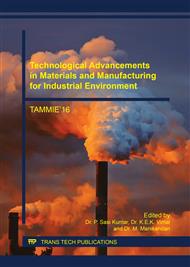[1]
Shanmughasundaram R., Subramanian G. Prabhu, Some Studies on Aluminium – Fly Ash Composites Fabricated by Two Step Stir Casting Method, European Journal of Scientific Research, Vol. 63, No. 2, (2011), pp.204-218.
DOI: 10.4028/www.scientific.net/amr.488-489.775
Google Scholar
[2]
Gaurav Chigal , Gaurav Saini, Mechanical testing of Al6061/silicon carbide metal matrix composite, International Journal of Research in Engineering & Applied Sciences, Volume 2, Issue 2. (2012).
Google Scholar
[3]
S.C. Mishra, Aluminum – fly ash composite produced by impeller mixing, Journal of reinforced plastics and composites , (2008), pp.1-6.
DOI: 10.1177/0731684408096428
Google Scholar
[4]
Sandeep Kumar, Ravesh, Dr.T. K. Garg, Preparation & Analysis For Some Mechanical Property Of Aluminium Based Metal Matrix Composite Reinforced With Sic & Fly Ash, International Journal of Engineering Research and Applications, Vol. 2, Issue 6, (2012).
Google Scholar
[5]
K. Sudershan Kumar, Dr.K. Tirupathi Reddy, Syed Altaf Hussain , Modelling and analysis of two Wheeler connecting rod, International Journal of Modern Engineering Research, Vol -2, Issue- 5, (2012).
Google Scholar
[6]
Vivek. c. pathade, Bhumeshwar Patle, Ajay N. Ingale, Stress Analysis of I.C. Engine Connecting Rod by FEM , International Journal of Engineering and Innovative Technology, Vol-1, Issue-3, (2012).
Google Scholar
[7]
Webster, Three Dimensional Finite Element Analysis of a High Speed Diesel Engine Connecting Rod, SAE Technical Paper Series, Paper No. 831322, ( 1983).
DOI: 10.4271/831322
Google Scholar
[8]
Yoo, shape optimal design of an engine connecting rod, journal of mechanisms transmissions, and Automation in Design, Asme, vol 106, (1984), pp.415-419.
DOI: 10.1115/1.3267428
Google Scholar
[9]
Pai, The shape optimization of a connecting rod with fatigue life constraint, International Journal of Materials and Product Technology, Vol. 11, No. 5-6, ( 1996), pp.357-370.
Google Scholar
[10]
H.C. Anilkumar , H.S. Hebbar and K.S. Ravishankar, Mechanical Properties of fly ash reinforced aluminium alloy(al 6061)composites, International Journal of Mechanical and Materials Engineering, Vol. 6 No. 1, (2011), pp.41-45.
Google Scholar
[11]
Folgar, Design Fabrication and Performance of Fiber FP/Metal Matrix Composite Connecting Rods, SAE Technical Paper Series, (1987), Paper No. 870406.
DOI: 10.4271/870406
Google Scholar
[12]
Park, H. Development of Fracture Split Steel Connecting Rods, SAE Technical Paper Series, Paper No. 2003-01-1309, (2003).
DOI: 10.4271/2003-01-1309
Google Scholar


